신생아 신체 발육(신생아의 신체 발달), Physical development in newborn infants
| 신생아의 두부(머리) |
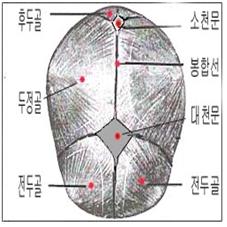
그림 2-19.신생아의 두개골, 봉합선, 대천문과 소천문.
Copyright ⓒ 2011 John Sangwon Lee, MD., FAAP
- 갓 태어난 신생아의 머리 둘레는 가슴둘레보다 더 큰 것이 보통이다.
- 갓 태어난 신생아의 몸통의 양쪽을 양손으로 붙들고 세워 앉히면 목이 힘이 없어 흔들거리는 것이 보통이다.
- 갓 태어난 신생아의 머리가 분만 중 산도에 눌려 몰딩(소형/주형)이 생길 수 있고 그 머리통의 모양에 변화가 산후 며칠 동안 계속될 수 있다.
- 출생 후 하루 이틀 삼일 동안 머리통이 한쪽으로 삐뚤어질 수 있고 머리통이 앞뒤로 길어질 수 있다.
- 분만 중 산도에 눌려 생긴 이런 종류의 머리통의 모양을 몰딩, 주형 또는 소형이라 한다(부모도 반의사가 되어야 한다-소아가정간호 백과-3권 성장발육-소형 참조).
- 산도에 눌려 생긴 불균형 머리통은 생후 2∼3일 내 본래 머리통의 모양으로 자연히 돌아가는 것이 보통이다.
- 갓 태어난 신생아의 머리통의 앞 위 중앙 부위를 손으로 만지면 물렁물렁한 국소가 한 개 있다.
- 이것이 대천문이다.
- 대천문을 숨구멍이라고 한다.
- 신생아들의 대천문의 크기는 생후 2∼3개월 된 영아들의 대천문의 크기보다 때로는 더 작을 수 있다.
- 대천문은 생후 2∼3개월 이후부터 점점 더 작아지기 시작해서 생후 18∼24개월이 될 때까지 완전히 막히는 것이 정상적이다.
- 신생아들이나 영아들에게 생긴 어떤 병을 진단하고 검진할 때 이 대천문을 육안으로 조심히 살펴보고 손으로 만져보면 거기서 임상적으로 중요한 정보를 얻을 수 있다.
| 신생아의 눈 |
- 갓 태어난 신생아들은 아주 작은 물체를 자세히 볼 수는 없지만 큼직한 물체를 볼 수 있는 시력을 가지고 있다.
- 갓 태어난 신생아들도 엄마 아빠의 얼굴을 쳐다볼 수 있고 엄마 아빠의 눈길 접촉 사랑을 느끼고 받을 수 있다.
- 부모는 사랑스런 좋은 눈길로 사랑해줘야 한다.
- 이 때 신생아들은 자기들이 가지고 있는 사랑의 탱크 속에 엄마아빠로 받은 사랑을 채워 넣는다.
- 생후 1∼2주 정도 되면 신생아들은 엄마 아빠가 웃는 얼굴을 확실히 알아볼 수 있다.
- 엄마 아빠가 웃으면 자기도 따라서 좋아하고 따라서 웃는다.
- 찡그린 엄마 아빠의 얼굴을 알아보고 자기도 기분 나빠한다.
- 신생아도 이렇게 몸짓 말로 웃고 울음 말로 엄마아빠와 대화를 하기 시작한다.
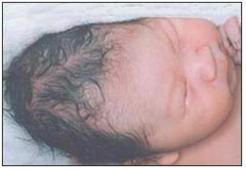
사진 2-20. 갓 태어난 신생아의 몰딩(소형).
분만 중 머리통이 이런 모양으로 위 아래로 길게 늘어나기도 하고 일시적으로 변형되는 것이 보통이다.
Copyright ⓒ 2011 John Sangwon Lee, MD., FAAP
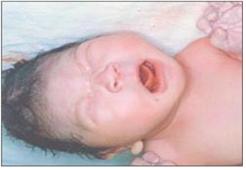
사진 2-22. 갓 태어난 신생아의 몰딩.
질 산도 속을 통과할 때 머리가 이런 모양으로 길게 늘어나기도 하고 변형되는 것이 보통이다. 선단 청색증으로 양 손이 파랗다. 이것은 일시적인 현상이고 정상이다.
Copyright ⓒ 2011 John Sangwon Lee, MD., FAAP
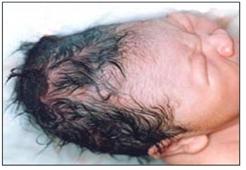
사진 2-23. 갓 태어난 신생아의 몰딩.
질 산도를 통과해서 출생할 때 머리가 이런 모양으로 위 아래로 길게 늘어나고 변형되는 것이 보통이다. 출생 후 하루사이에 본래의 머리모양으로 돌아가는 것이 보통이다.
Copyright ⓒ 2011 John Sangwon Lee, MD., FAAP
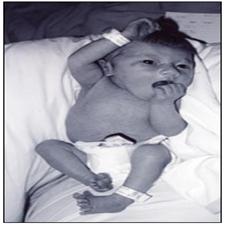
사진2-24.갓 태어난 아기.
손가락을 빨고 있다. 빠는 흡철반사, 모로반사, 긴장성 경반사 등 원시반사를 갖고 태어난다.
Copyright ⓒ 2011 John Sangwon Lee, MD., FAAP
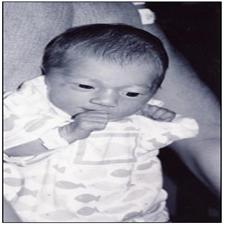
사진2-25.갓 태어난 아기.
불과 태어난 후 며칠 사이에 이렇게 이쁜 아기로 성장 발육한다. Copyright ⓒ 2011 John Sangwon Lee, MD., FAAP
Physical development in newborn infants Newborn’s head (head) 신생아 신체 발육(신생아의 신체 발달)
Figure 2-19: Newborn skull, sutures, large anterior fontanel, and small posterior fontanel. Copyright ⓒ 2011 John Sangwon Lee, MD., FAAP
- Newborn babies’ head circumference is usually larger than the chest circumference.
- When a newborn baby’s torso is held with both hands and seated upright, it is common for the neck to shake due to a lack of strength.
- The head of a newborn baby can be pressed against the birth canal during delivery, resulting in moldings, and changes in the shape of the head can continue for several days postpartum.
- For a day or two after birth, the head can be skewed to one side and the head can be lengthened back and forth.
- The shape of this type of head, which is pressed by the birth canal during delivery, is called a molding, a mold, or a small size (parents should also be at least the half -doctors-see Encyclopedia of Child and Family Nursing-Volume 3 Growth and Development-Small).
- It is common for the unbalanced head formed by pressing on the birth canal to naturally return to the shape of the original head within 2-3 days after birth.
- If you touch the center of the front and top of a newborn baby’s head, there is one soft spot. This is great anterior fontanel. The great anterior fontanel is called a breathing hole.
- The size of the grand anterior fontanel in newborns can sometimes be smaller than the size of the grand anterior fontanel in infants 2 to 3 months old. It is normal for anterior fontanel to start getting smaller and smaller after 2-3 months of age and completely block until 18-24 months of age.
- When diagnosing and examining certain diseases in newborns or infants, you can carefully examine this large anterior fontanel with the naked eye and touch it with your hands to obtain clinically important information there.
Newborn’s eyes
- Newborn babies cannot see very small objects in detail, but they have the vision to see larger objects.
- Newborn newborns can also look at the face of mom and dad and feel and receive the love of their mom and dad’s eye contact.
- Parents should love them with a lovely, good glance.
- At this time, the newborns fill their love tanks with the love they received from their mother and father.
- When they are 1 to 2 weeks old, newborns can clearly recognize the smiling face of their mother and father.
- When mom and dad laugh, she likes and laughs accordingly.
- After recognizing the face of the frowning mom and dad, she feels bad too.
- The newborn also begins to talk with her mom and dad through gestures and crying.

- Photo 2-20. Newborn’s molding. During delivery, the head is usually stretched up and down in this shape and temporarily deformed. Copyright ⓒ 2011 John Sangwon Lee, MD., FAAP

Photo 2-22. Molding of newborn newborns.
It is common for the head to elongate or deform in this shape as it passes through the birth canal. Both hands are blue due to tip cyanosis. This is a temporary phenomenon and is normal. Copyright ⓒ 2011 John Sangwon Lee, MD., FAAP

Photo 2-23. Molding of newborn newborns. It is common for the head to elongate and deform up and down in this shape when born through the vaginal birth canal. It is common for the hair to return to its original shape within one day after birth. Copyright ⓒ 2011 John Sangwon Lee, MD., FAAP

Picture 2-24. Newborn baby. Newborn babies are sucking their fingers. They are born with primitive reflexes such as sucking reflex, Moro reflection, and tension neck reflex. Copyright ⓒ 2011 John Sangwon Lee, MD., FAAP

Picture 2-25. Newborn baby. Just a few days after birth, it grows and develops into such a pretty baby. Copyright ⓒ 2011 John Sangwon Lee, MD., FAAP
출처 및 참조 문헌
- NelsonTextbook of Pediatrics 22ND Ed
- The Harriet Lane Handbook 22ND Ed
- Growth and development of the children
- Red Book 32nd Ed 2021-2024
- Neonatal Resuscitation, American Academy Pediatrics
- www.drleepediatrics.com 제1권 소아청소년 응급 의료
- www.drleepediatrics.com 제2권 소아청소년 예방
- www.drleepediatrics.com 제3권 소아청소년 성장 발육 육아
- www.drleepediatrics.com 제4권 모유,모유수유, 이유
- www.drleepediatrics.com 제5권 인공영양, 우유, 이유식, 비타민, 미네랄, 단백질, 탄수화물, 지방
- www.drleepediatrics.com 제6권 신생아 성장 발육 육아 질병
- www.drleepediatrics.com제7권 소아청소년 감염병
- www.drleepediatrics.com제8권 소아청소년 호흡기 질환
- www.drleepediatrics.com제9권 소아청소년 소화기 질환
- www.drleepediatrics.com제10권. 소아청소년 신장 비뇨 생식기 질환
- www.drleepediatrics.com제11권. 소아청소년 심장 혈관계 질환
- www.drleepediatrics.com제12권. 소아청소년 신경 정신 질환, 행동 수면 문제
- www.drleepediatrics.com제13권. 소아청소년 혈액, 림프, 종양 질환
- www.drleepediatrics.com제14권. 소아청소년 내분비, 유전, 염색체, 대사, 희귀병
- www.drleepediatrics.com제15권. 소아청소년 알레르기, 자가 면역질환
- www.drleepediatrics.com제16권. 소아청소년 정형외과 질환
- www.drleepediatrics.com제17권. 소아청소년 피부 질환
- www.drleepediatrics.com제18권. 소아청소년 이비인후(귀 코 인두 후두) 질환
- www.drleepediatrics.com제19권. 소아청소년 안과 (눈)질환
- www.drleepediatrics.com 제20권 소아청소년 이 (치아)질환
- www.drleepediatrics.com 제21권 소아청소년 가정 학교 간호
- www.drleepediatrics.com 제22권 아들 딸 이렇게 사랑해 키우세요
- www.drleepediatrics.com 제23권 사춘기 아이들의 성장 발육 질병
- www.drleepediatrics.com 제24권 소아청소년 성교육
- www.drleepediatrics.com 제25권 임신, 분만, 출산, 신생아 돌보기
- Red book 29th-31st edition 2021
- Nelson Text Book of Pediatrics 19th- 21st Edition
- The Johns Hopkins Hospital, The Harriet Lane Handbook, 22nd edition
- 응급환자관리 정담미디어
- Pediatric Nutritional Handbook American Academy of Pediatrics
- 소아가정간호백과–부모도 반의사가 되어야 한다, 이상원 저
- The pregnancy Bible. By Joan stone, MD. Keith Eddleman, MD
- Neonatology Jeffrey J. Pomerance, C. Joan Richardson
- Preparation for Birth. Beverly Savage and Dianna Smith
- 임신에서 신생아 돌보기까지. 이상원
- Breastfeeding. by Ruth Lawrence and Robert Lawrence
- Sources and references on Growth, Development, Cares, and Diseases of Newborn Infants
- Emergency Medical Service for Children, By Ross Lab. May 1989. p.10
- Emergency care, Harvey Grant and Robert Murray
- Emergency Care Transportation of Sick and Injured American Academy of Orthopaedic Surgeons
- Emergency Pediatrics A Guide to Ambulatory Care, Roger M. Barkin, Peter Rosen
- Quick Reference To Pediatric Emergencies, Delmer J. Pascoe, M.D., Moses Grossman, M.D. with 26 contributors
- Neonatal resuscitation Ameican academy of pediatrics
- Pediatric Nutritional Handbook American Academy of Pediatrics
- Pediatric Resuscitation Pediatric Clinics of North America, Stephen M. Schexnayder, M.D.
-
Pediatric Critical Care, Pediatric Clinics of North America, James P. Orlowski, M.D.
-
Preparation for Birth. Beverly Savage and Dianna Smith
-
Infectious disease of children, Saul Krugman, Samuel L Katz, Ann A.
- 제4권 모유, 모유수유, 이유 참조문헌 및 출처
- 제5권 인공영양, 우유, 이유, 비타민, 단백질, 지방 탄수 화물 참조문헌 및 출처
- 제6권 신생아 성장발육 양호 질병 참조문헌 및 출처
- 소아과학 대한교과서
|
Copyright ⓒ 2015 John Sangwon Lee, MD., FAAP 미국 소아과 전문의, 한국 소아청소년과 전문의 이상원 저 “부모도 반의사가 되어야 한다”-내용은 여러분들의 의사로부터 얻은 정보와 진료를 대신할 수 없습니다. “The information contained in this publication should not be used as a substitute for the medical care and advice of your doctor. There may be variations in treatment that your doctor may recommend based on individual facts and circumstances. “Parental education is the best medicine.” |